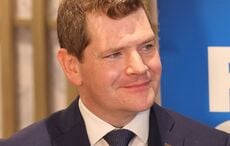Frank Connolly was the journalist who originally broke the story about corruption at the highest level in Irish politics. He was vilified and threatened, but now the Mahon report has confirmed his findings about what he first wrote about in 1999. Here is his expose on how it all came about.
The key to unlocking the door to the endemic corruption in Ireland was provided by Sligo native, Tom Gilmartin, who emigrated to England in 1957 where he developed a successful mechanical engineering business. When he witnessed the homeless Irish arriving in Luton, where he lived with his wife and family, during the recession of the 1980’s he decided to return to Ireland to try and generate employment with two ambitious retail projects.
With a £20 million investment fund promised by English investors and independent wealth from his successful enterprises, Gilmartin sought to build a large shopping development at Bachelors Walk in Dublin’s city centre while he also began to assemble lands at Quarryvale at a strategic junction where the main route to the west of Ireland converged with the M50 ring road around the city. His success in assembling the Quarryvale lands attracted the interest of the country’s largest bank, Allied Irish Bank and one of its favoured clients the Cork property developer and politically well connected, Owen O’Callaghan.
When I first spoke to Gilmartin in 1998, he told me that as soon as he sought to get his plans off the ground he was confronted, in 1988, with outrageous demands for money from another Fianna Fáil politician, the late Liam Lawlor and a senior official in City Hall, George Redmond.
After he refused to pay the £100,000 each they demanded he discovered that he was meeting commercially draining, bureaucratic and political obstacles at every turn.
After a meeting with the then prime minister, Charles Haughey and a group of cabinet ministers in Government buildings in Leinster House in February 1989, he was approached outside the door by a man who gave him a piece of paper with the code number of an offshore bank account in the British controlled tax haven, the Isle of Man, and asked to lodge £5 million.
“You make the f…… mafia look like monks,” Gilmartin told the hustler.
When he complained about all of these obstacles to Padraig Flynn the then environment minister asked him to make a donation to Fianna Fáil. Just leave the payee blank, Flynn told him. Instead of going to Fianna Fáil the £50,000 donation ended up in Flynn’s bank accounts and a portion was used by his wife to buy a farm in county Mayo.
When Gilmartin went to the police to have them investigate he was called by a man purporting to be a senior officer and told to “feck off back to England.” The police investigation file from 1989 exonerated the politicians and officials, including Lawlor, who has since been jailed on three occasions for failing to comply with tribunal court orders. He died in a car accident in Moscow in 2005 while still under tribunal investigation after it discovered he had opened more than a hundred bank accounts in numerous jurisdictions. Lawlor had previously been appointed by Bertie Ahern as chairman of the Irish parliament’s ethics committee.
As for Gilmartin, within a short few years Gilmartin was ousted unable to get his planning permission and Owen O’Callaghan and AIB controlled his company, Barkhill. A former Fianna Fáil press officer turned public relations man, Frank Dunlop, admitted later to bribing up to one third of the members of Dublin County Council on behalf of O’Callaghan and other clients in order to influence planning and zoning decisions, including in the effort to frustrate Gilmartin’s other development at Quarryvale. False allegations from Dublin led to an unjustified demand on Gilmartin for £14 million by the British Inland Revenue service which had a devastating impact on his life and family. The service later apologised.
Now the 15 year judicial inquiry, known as the Mahon tribunal, has revealed the entire catalogue of political corruption through the 1980’s and 1990’s that reached into the heart of the Irish state.
The 3,000 page report cited a number of senior politicians, including former prime minister, Bertie Ahern, who was accused of lying to the investigation about the source of over £250,000 which went through various bank accounts when he was finance minister in the early 1990s.
Another former prime minister, Albert Reynolds, stands accused of inappropriately soliciting payments for the Fianna Fáil party from businessmen who were seeking commercial favours from the Government he headed during the same period. A former minister in his government and later European Union commissioner, Padraig Flynn, was accused of corruptly asking for, and then pocketing, a €50,000 donation given to the party by a property developer in 1989.
Since the report into planning corruption in Dublin was published, on Thursday (22nd March), Ahern has dramatically resigned from the party he led into Government three times since 1997 - just days ahead of a meeting where its national executive was to vote on a proposal from current leader, Micheál Martin, to expel him. Flynn has jumped ship also.
Ahern, who was once dubbed the “most skilful, the most devious, the most cunning of them all” by his mentor, Haughey, has been proven to have been too clever by half in his tribunal evidence.
His explanations concerning the source of large cash sums, including dollar and sterling amounts, which flowed through various accounts under his control in the early 1990s was rubbished in the tribunal report. The associates who gave evidence that they had collected cash for him, or ‘dig-outs’, to help him through a time when the politician had marital problems were accused of lying on his behalf. In desperation, he claimed that he had won significant amounts of the sterling sums ‘on the horses’. He was forced to resign as Taoiseach in 2008 over his ‘incredible’ evidence at the tribunal.
Its investigation into his personal finances commenced when Gilmartin informed tribunal lawyers of a conversation with the aforementioned Cork developer Owen O’Callaghan during which the Cork developer said he had paid up to £80,000 in bribes to Ahern between 1989 and 1994.
When I published the sensational story in 2002 that the tribunal was examining this allegation against the prime minister all hell broke loose. The then justice minister, Michael McDowell, went on national radio to attack me, claiming the story was untrue. When I challenged him to point out the inaccuracy he was unable to do so.
Days later, Ahern told reporters that he had never taken a corrupt payment in his political life. Two years on, as the tribunal inquiries proceeded at a snail’s pace, not least because of legal and other delays put in its way by those it was investigating, I joined the Chuck Feeney funded Centre for Public Inquiry as its executive director. As we set about investigating matters of public importance I became the subject of a vicious campaign led by Ahern and McDowell until the funding was withdrawn in late 2005.
When I returned to newspaper journalism I took up where I had left off in relation to the tribunal investigations and published a series of investigative articles which highlighted the extraordinary details of Ahern’s duplicity. Among the huge amounts he received was a $45,000 sum in late 1994 just as the Reynolds led government disintegrated. Weeks earlier, Ahern had met with Los Angeles broker, Bill O’Connor of Chilton O’Connor, and O’Callaghan, to discuss a sports stadium they were promoting in west Dublin.
The tribunal has not established a direct link between monies received by Ahern and decisions he made as finance minister but its comprehensive report has pointed to a litany of suspicious behaviour. It is now fair to ask another question. If he was in receipt of such unexplained amounts of money when finance minister what did he make when Prime Minister for eleven years.




Comments